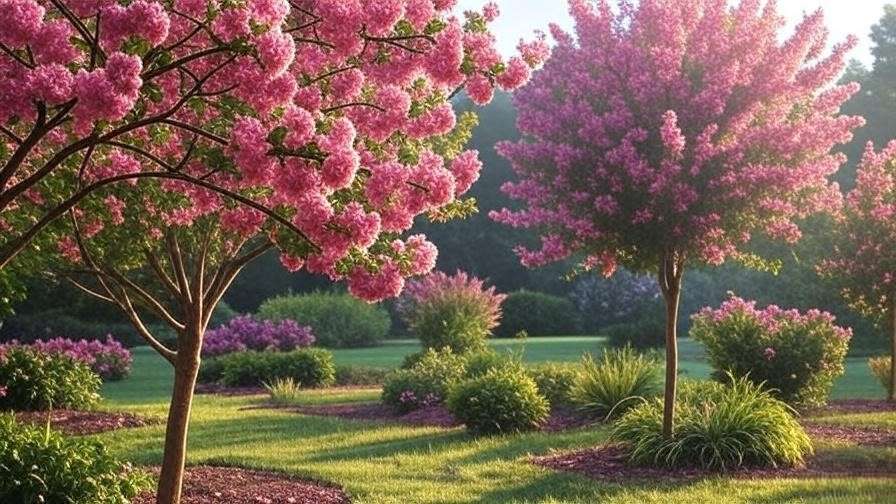Imagine stepping into your garden and being greeted by a cascade of vibrant pink blossoms, their delicate petals swaying in the breeze, transforming your outdoor space into a serene oasis. Flowering trees with pink blossoms are more than just eye candy—they’re a gardener’s dream, blending aesthetic charm with ecological benefits. Whether you’re a seasoned horticulturist or a homeowner looking to elevate your landscape, these trees offer a perfect mix of beauty, functionality, and seasonal interest. In this comprehensive guide, we’ll explore the top 10 flowering trees with pink blossoms, share expert care tips, and provide design ideas to make your garden the envy of the neighborhood. Backed by years of horticultural expertise and trusted sources like the Royal Horticultural Society, this article will help you choose the perfect tree to suit your climate, space, and style. 🌺
The Allure of Pink Blossoms in Landscaping 🌺
Why Choose Pink Flowering Trees?
Pink flowering trees are a gardener’s secret weapon for creating a visually stunning landscape. The soft, romantic hues of pink evoke feelings of calm and joy, making them a favorite for both modern and cottage-style gardens. Their vibrant blooms act as natural focal points, drawing the eye and adding a pop of color that complements greenery, whites, and purples. For example, pairing a pink-blossomed tree with lavender or white peonies creates a harmonious, layered look that’s both elegant and inviting.
Beyond aesthetics, pink blossoms signal spring’s arrival, offering a burst of seasonal cheer. Varieties like cherry blossoms or crabapples bloom reliably year after year, ensuring your garden stays dynamic and engaging. Their versatility makes them suitable for urban yards, suburban lawns, or even container gardens for smaller spaces. 🌸
Benefits Beyond Beauty
Pink flowering trees do more than beautify your yard—they contribute to a healthier ecosystem. Many, like the Eastern redbud, attract pollinators such as bees and butterflies, supporting biodiversity. Their blooms provide nectar early in the season when pollinators need it most. Additionally, these trees offer practical benefits: shade for hot summer days, privacy screens for urban lots, or even edible fruit for wildlife, as seen in some crabapple varieties.
From an environmental perspective, trees like the desert willow are drought-tolerant, making them ideal for water-conscious gardeners. Others, like the crape myrtle, provide multi-season interest with vibrant fall foliage and textured bark in winter. Whether you’re aiming for a low-maintenance landscape or a wildlife-friendly haven, these trees deliver. 🐝
Top 10 Flowering Trees with Pink Blossoms 🌸
Below, we dive into the top 10 flowering trees with pink blossoms, each chosen for its beauty, adaptability, and ease of care. For each, we’ll cover key features, growing conditions, and expert tips to ensure success in your garden.
1. Cherry Blossom (Prunus spp.) 🍒
Description: Cherry blossoms are synonymous with spring, their delicate pink petals creating a breathtaking canopy. Varieties like ‘Kanzan’ boast double blooms for extra drama.
Key Features: Fast-growing, these trees reach 15-25 feet and produce stunning spring displays. Their cultural significance in Japanese gardens adds a touch of history to your landscape.
Care Tips: Plant in well-drained soil with full sun exposure. Prune after flowering to maintain shape and remove dead wood. Watch for pests like aphids and treat with neem oil if needed.
Growing Zones: USDA Zones 5-8.
Expert Insight: The National Cherry Blossom Festival in Washington, D.C., showcases the global love for these trees, drawing millions to celebrate their fleeting beauty.
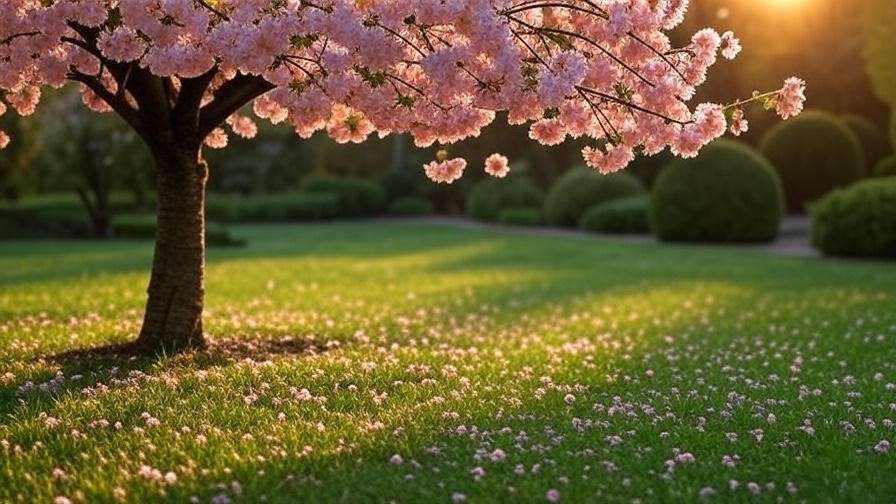
2. Crabapple (Malus spp.) 🍎
Description: Crabapples dazzle with vibrant pink blooms in spring, followed by small, colorful fruit that attracts birds.
Key Features: Compact varieties like ‘Prairifire’ grow to 15-20 feet and offer disease resistance, making them low-maintenance. Their spring blooms and fall fruit provide year-round interest.
Care Tips: Ensure well-drained soil and full sun. Prune annually to improve air circulation and reduce disease risk. Water moderately, especially during establishment.

Growing Zones: USDA Zones 4-8.
3. Eastern Redbud (Cercis canadensis) 💗
Description: This native North American tree boasts heart-shaped leaves and clusters of pink-purple blossoms that appear before foliage.
Key Features: Early spring blooms, drought tolerance, and a compact size (20-30 feet) make it ideal for small yards. Its vibrant fall color adds extra appeal.
Care Tips: Plant in partial shade to full sun with well-drained soil. Mulch to retain moisture and avoid overwatering.
Growing Zones: USDA Zones 4-9.
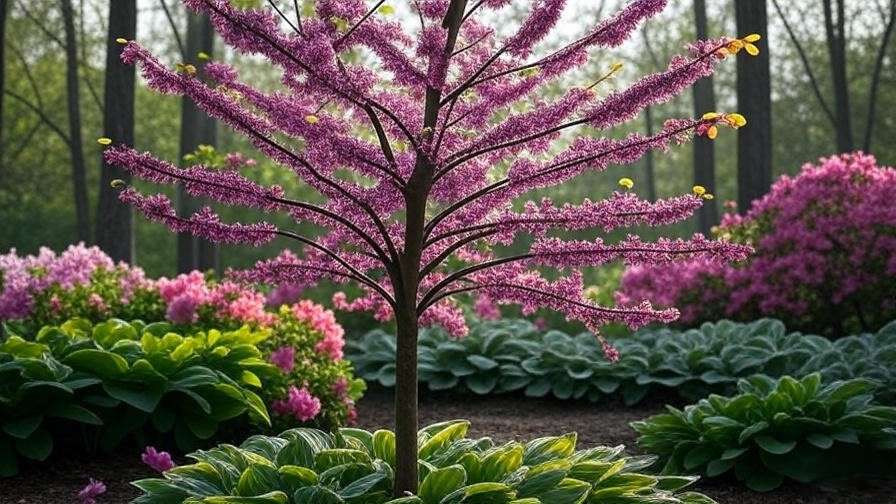
4. Flowering Dogwood (Cornus florida) 🌼
Description: Known for elegant pink bracts surrounding tiny flowers, this tree is a Southern classic.
Key Features: Four-season interest with spring blooms, red berries, and vivid fall foliage. Grows to 15-30 feet, perfect for mixed borders.
Care Tips: Prefers acidic, well-drained soil and partial shade. Mulch to protect roots and water consistently during dry spells.
Growing Zones: USDA Zones 5-9.
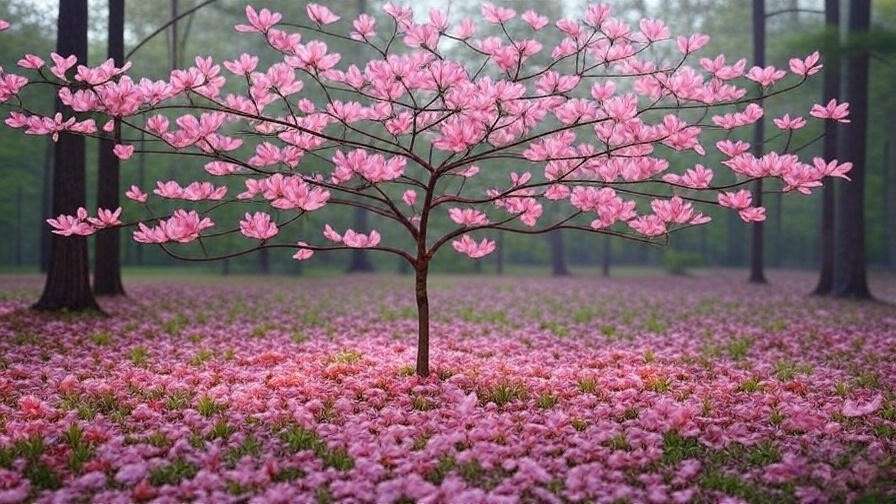
5. Saucer Magnolia (Magnolia x soulangeana) 🌷
Description: Large, cup-shaped pinkish-purple blooms steal the show in early spring, often before leaves emerge.
Key Features: Fragrant flowers and a compact size (15-25 feet) make it ideal for small gardens. Its glossy leaves add summer interest.
Care Tips: Plant in rich, well-drained soil with full sun to partial shade. Protect from late frosts, which can damage early blooms.
Growing Zones: USDA Zones 4-9.
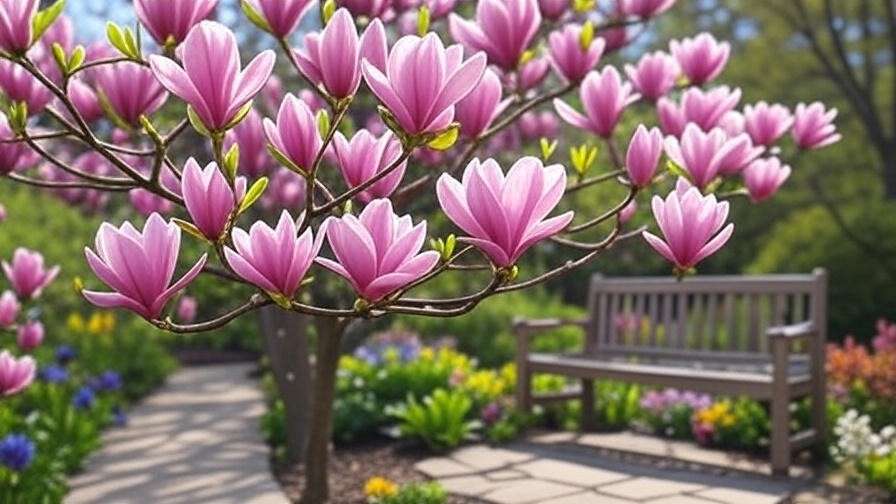
6. Pink Flowering Almond (Prunus glandulosa) 🌸
Description: A dwarf, shrub-like tree with profuse double pink blooms, perfect for tight spaces.
Key Features: Grows to 4-6 feet, making it ideal for patios or borders. Low maintenance and deer-resistant.
Care Tips: Full sun and moderate watering. Prune after blooming to maintain shape and encourage next year’s flowers.
Growing Zones: USDA Zones 4-8.
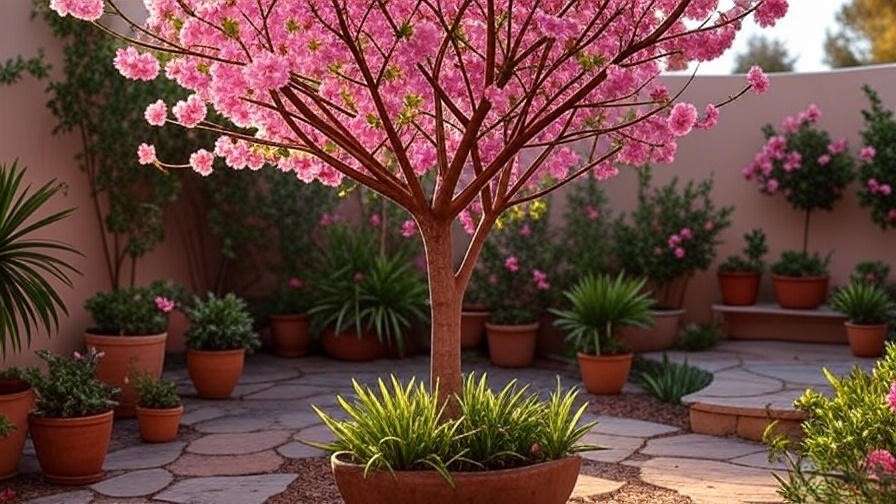
7. Japanese Flowering Apricot (Prunus mume) 🍑
Description: Early-blooming pink flowers with a sweet fragrance brighten late winter or early spring.
Key Features: Grows to 15-20 feet, with some varieties producing edible fruit. Ideal for adding early-season color.
Care Tips: Well-drained soil, full sun, and frost protection for early blooms. Prune lightly after flowering.
Growing Zones: USDA Zones 6-9.
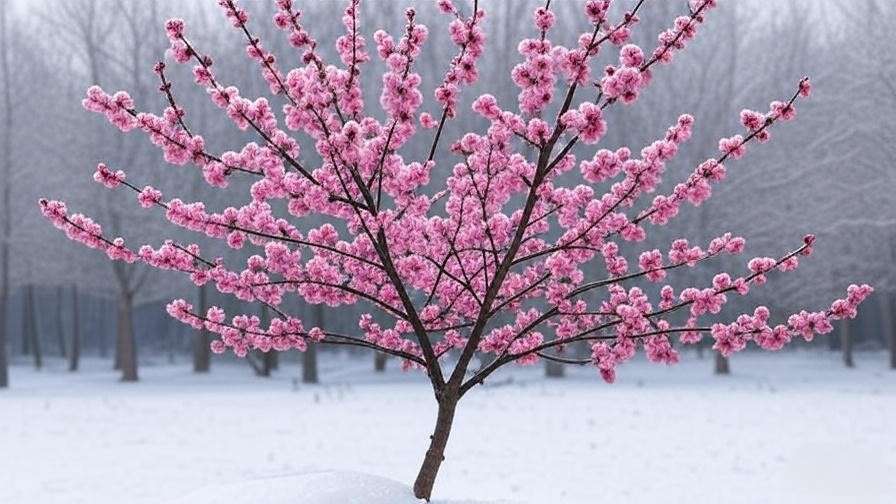
8. Desert Willow (Chilopsis linearis) 🏜️
Description: This desert-adapted tree features trumpet-shaped pink flowers, perfect for arid climates.
Key Features: Drought-tolerant and attractive to hummingbirds, it grows to 15-30 feet with a graceful, open canopy.
Care Tips: Plant in sandy, well-drained soil with full sun. Minimal watering once established.
Growing Zones: USDA Zones 7-9.
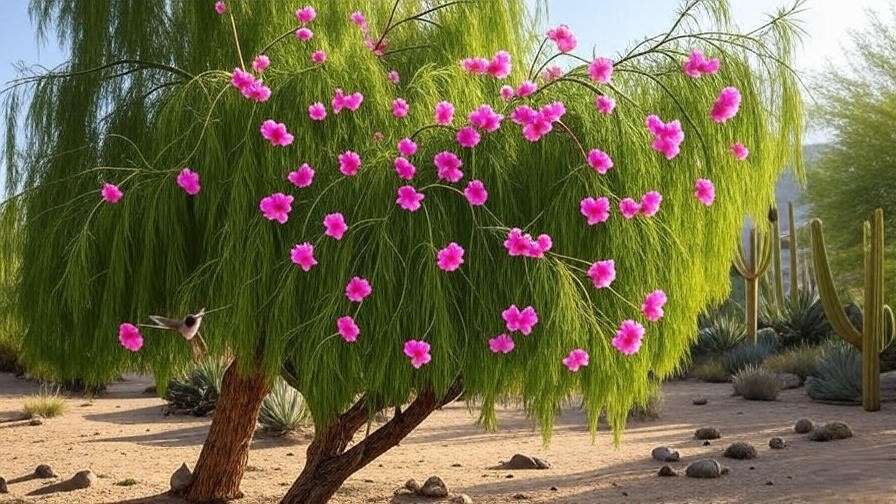
9. Pink Trumpet Tree (Tabebuia impetiginosa) 🌴
Description: A tropical beauty with vibrant pink trumpet-shaped blooms, ideal for warm climates.
Key Features: Fast-growing to 20-30 feet, with showy flowers that attract pollinators. Perfect for coastal or subtropical gardens.
Care Tips: Requires warm temperatures, well-drained soil, and full sun. Protect from frost in cooler zones.
Growing Zones: USDA Zones 9-11.
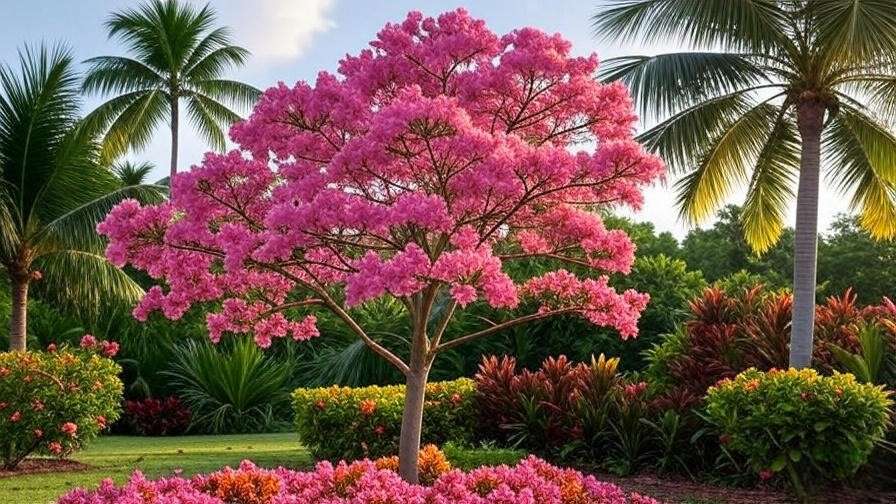
10. Crape Myrtle (Lagerstroemia indica) 🌺
Description: Long-lasting pink blooms in summer, followed by vibrant fall foliage and textured bark in winter.
Key Features: Heat-tolerant, with sizes ranging from dwarf (3-5 feet) to large (20-30 feet). Highly adaptable.
Care Tips: Full sun, well-drained soil, and late-winter pruning to encourage blooms.
Growing Zones: USDA Zones 6-9.
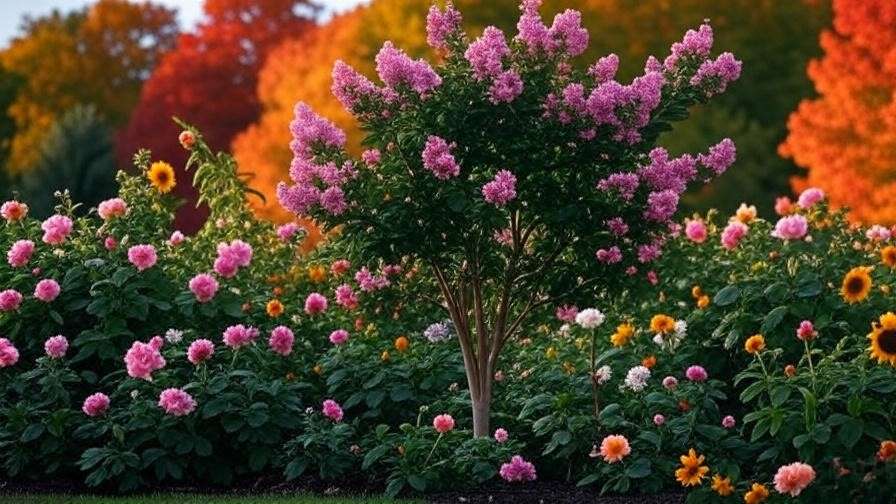
How to Choose the Perfect Pink Flowering Tree for Your Garden 🌳
Selecting the right flowering tree with pink blossoms requires careful consideration of your climate, garden size, and aesthetic goals. Below, we break down the key factors to ensure your chosen tree thrives and enhances your landscape.
Consider Your Climate and Hardiness Zone
The USDA Hardiness Zone map is your best friend when choosing a pink flowering tree. Each tree listed above thrives in specific zones, which indicate the average minimum winter temperatures in your region. For example, cherry blossoms (Zones 5-8) are ideal for temperate climates, while pink trumpet trees (Zones 9-11) suit warmer, subtropical areas. Use the table below for a quick reference:
| Tree | USDA Zones |
|---|---|
| Cherry Blossom | 5-8 |
| Crabapple | 4-8 |
| Eastern Redbud | 4-9 |
| Flowering Dogwood | 5-9 |
| Saucer Magnolia | 4-9 |
| Pink Flowering Almond | 4-8 |
| Japanese Flowering Apricot | 6-9 |
| Desert Willow | 7-9 |
| Pink Trumpet Tree | 9-11 |
| Crape Myrtle | 6-9 |
Tip: Check your local USDA zone using resources like the Arbor Day Foundation’s zone finder to ensure compatibility. 🌍
Match Trees to Your Garden’s Needs
Your garden’s size and purpose play a big role in tree selection. For small urban yards or patios, compact options like the pink flowering almond (4-6 feet) or dwarf crape myrtle varieties are perfect. Larger landscapes can accommodate stately trees like cherry blossoms or pink trumpet trees, which provide shade and act as dramatic focal points.
Consider your goals:
- Ornamental Beauty: Cherry blossoms or saucer magnolias for show-stopping blooms.
- Shade: Crabapples or Eastern redbuds for dappled shade.
- Wildlife Attraction: Desert willows or crabapples to draw hummingbirds and birds.
For example, a small urban garden might feature a pink flowering almond paired with low-growing perennials like catmint for a cohesive look. 🌼
Soil, Sun, and Water Requirements
Most pink flowering trees prefer well-drained soil, but specific needs vary. For instance, flowering dogwoods thrive in acidic soil, while desert willows tolerate sandy, alkaline conditions. Test your soil’s pH before planting—kits are available at garden centers or through university extension services.
Sun exposure is critical for vibrant blooms. Cherry blossoms and crape myrtles demand full sun (6+ hours daily), while Eastern redbuds and dogwoods tolerate partial shade. Watering needs also differ: young trees require consistent moisture, while established desert willows or crape myrtles are drought-tolerant. Mulching around the base retains moisture and regulates soil temperature. 💧
Planting and Caring for Your Pink Flowering Tree 🌱
Best Time to Plant
Spring and fall are ideal for planting pink flowering trees, as cooler temperatures allow roots to establish without the stress of summer heat or winter frost. In warmer climates (Zones 9-11), early fall planting works well for trees like pink trumpet trees. Avoid planting during extreme heat or freezing conditions to prevent transplant shock.
Step-by-Step Planting Guide
- Choose the Right Spot: Ensure adequate sunlight and space for the tree’s mature size.
- Dig the Hole: Make it twice as wide and as deep as the root ball.
- Amend the Soil: Mix compost or organic matter with native soil for nutrient-rich planting.
- Position the Tree: Place the root ball level with the ground, ensuring the root flare is visible.
- Backfill and Water: Fill the hole, tamp down gently, and water thoroughly.
- Mulch and Stake: Apply 2-3 inches of mulch (avoid touching the trunk) and stake if needed for stability.
Visual Aid Suggestion: Include a diagram showing proper planting depth, with the root flare above soil level to prevent rot. 🌳
Ongoing Care Tips
- Watering: Water young trees weekly (1-2 inches) during the first year. Established trees need less frequent watering, except during drought.
- Pruning: Prune after flowering to maintain shape and remove dead or crossing branches. For example, cherry blossoms and crape myrtles benefit from light pruning in late winter or early spring.
- Pest and Disease Management: Monitor for common issues like powdery mildew (dogwoods) or aphids (crabapples). Use organic solutions like neem oil or insecticidal soap. Regular inspection and good air circulation prevent most problems.
Expert Tip: Fertilize sparingly with a balanced, slow-release fertilizer (e.g., 10-10-10) in early spring to boost growth without overstimulating foliage at the expense of blooms. 🌿
Design Ideas for Pink Flowering Trees in Your Landscape 🏡
Creating a Focal Point
A single pink flowering tree can anchor your garden’s design. A cherry blossom or saucer magnolia planted in the center of a lawn creates a stunning centerpiece, especially when underplanted with groundcovers like creeping thyme. Highlight the tree with subtle landscape lighting to showcase its blooms at night. 💡
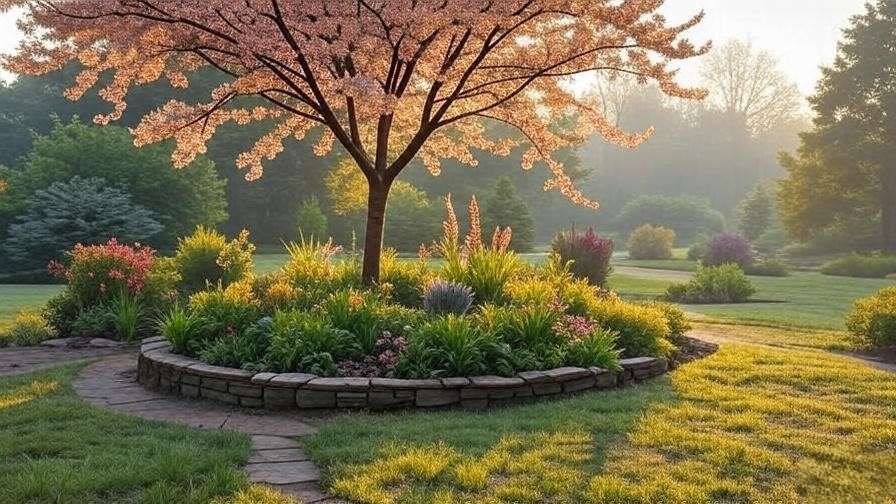
Mixed Borders and Group Plantings
For a layered look, combine pink flowering trees with shrubs and perennials. For example, pair an Eastern redbud with azaleas and hostas for a woodland-inspired border. The redbud’s pink blooms contrast beautifully with azalea’s vibrant colors, while hostas add lush foliage at the base.
Seasonal Pairings
Plan for year-round interest by pairing trees with complementary plants. A crape myrtle’s summer pink blooms pop against fall-blooming asters or ornamental grasses. In spring, underplant crabapples with tulips or daffodils for a cheerful display. These combinations ensure your garden stays vibrant across seasons. 🌸
Common Mistakes to Avoid When Growing Pink Flowering Trees 🚫
- Overwatering: Poor drainage can lead to root rot, especially in dogwoods or magnolias. Ensure proper soil drainage and avoid waterlogged conditions.
- Incorrect Pruning: Pruning at the wrong time (e.g., before flowering) can reduce blooms. Always prune after flowering for spring-blooming trees like cherry blossoms.
- Ignoring Soil and Zone Compatibility: Planting a pink trumpet tree in Zone 6 will lead to failure. Match trees to your USDA zone and soil type.
- Neglecting Maintenance: Skipping annual inspections for pests or diseases can weaken trees. Regular care ensures long-term health.
Expert Tip: Test your soil’s pH and drainage before planting. A simple soil test kit can save you from costly mistakes. 🌱
FAQs About Flowering Trees with Pink Blossoms ❓
Q: Which pink flowering tree is easiest to grow?
A: Crape myrtle is low-maintenance, heat-tolerant, and adaptable to various soil types, making it ideal for beginners.
Q: Can pink flowering trees grow in shade?
A: Eastern redbud and flowering dogwood thrive in partial shade, though most prefer full sun for optimal blooming.
Q: How long do pink blossoms last?
A: Bloom times vary—cherry blossoms last 2-4 weeks, while crape myrtles can bloom for months in summer.
Q: Are these trees safe for pets?
A: Most are non-toxic, but avoid letting pets ingest cherry blossom pits or crabapple fruit, which can be harmful in large quantities.
Conclusion: Transform Your Garden with Pink Flowering Trees 🌸
Flowering trees with pink blossoms are a perfect blend of beauty, functionality, and ecological value. From the iconic cherry blossom to the drought-tolerant desert willow, these trees offer something for every gardener, whether you’re creating a romantic cottage garden or a modern urban oasis. By choosing the right tree for your climate, planting it properly, and providing ongoing care, you’ll enjoy years of vibrant blooms and seasonal interest. Ready to transform your garden? Pick one of these stunning trees, follow our expert tips, and share your blooming success on social media with #PinkBlossomGarden! 🌺

